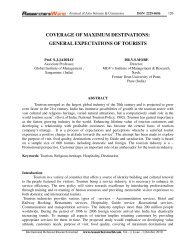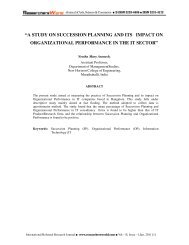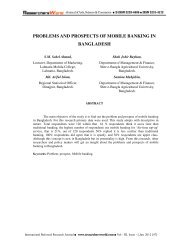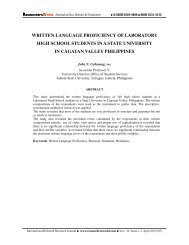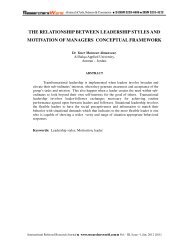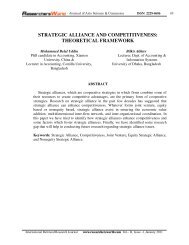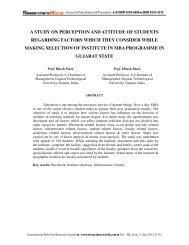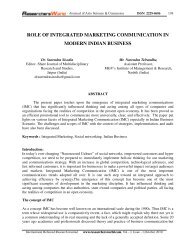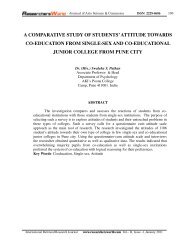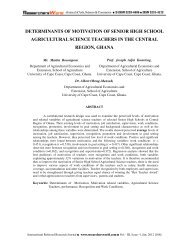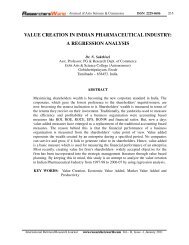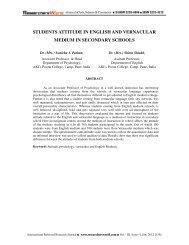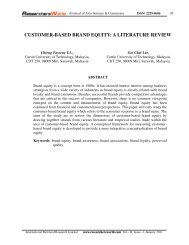settlement patterns and economic development - Researchers World
settlement patterns and economic development - Researchers World
settlement patterns and economic development - Researchers World
Create successful ePaper yourself
Turn your PDF publications into a flip-book with our unique Google optimized e-Paper software.
-Journal of Arts, Science & Commerce ■ E-ISSN 2229-4686 ■ ISSN 2231-4172<br />
INTRODUCTION:<br />
The discussion of <strong>settlement</strong> <strong>patterns</strong> examines the historical flows <strong>and</strong> migration <strong>patterns</strong> of<br />
the population over time. By observing past <strong>and</strong> present <strong>settlement</strong> <strong>patterns</strong> we can observe the<br />
impact of change on different communities. Konseiga (2005) has noted that West Africa is an area<br />
with a long tradition of human mobility, which was enhanced particularly during the colonial period.<br />
However, after independence, this population mobility turned into labour migration for wage work,<br />
weaving a complex grid of relations <strong>and</strong> inter-dependence over the artificial borders inherited from<br />
colonialism. Migration remained very attractive because migrants were not disconnected from their<br />
home country.<br />
Ghana has a long history <strong>and</strong> a tradition of planning national <strong>development</strong>. According to the<br />
2001 Organization for Economic Cooperation <strong>and</strong> Development (OECD) publication, preindependence<br />
Gold Coast completed the first <strong>development</strong> plan in the world – known then as the<br />
Guggisberg Plan in 1919. The plan sought to develop the Gold Coast up to 1926. However, 53 years<br />
after independence in 1957, the <strong>development</strong> <strong>patterns</strong> that have emerged manifest major inequalities<br />
among rural communities. The disparities are clearly seen in the rural districts of Ghana of which<br />
Twifo-Hemang-Lower Denkyira (THLD) District (focus of this study) is a living example was<br />
established by Legislative Instrument (L.I) 1377 in 1988.<br />
The study focuses on six communities in the Twifo-Hemang-Lower Denkyira District in the<br />
Central Region of Ghana to examine the <strong>development</strong> <strong>patterns</strong> by comparing situations among three<br />
distinct groups of <strong>settlement</strong>s namely the indigenes, mixed <strong>and</strong> settler communities. This is important<br />
because the definition of settler <strong>and</strong> indigene often determines who gets what, <strong>and</strong> when <strong>and</strong> how<br />
they get it in such communities (Orock, 2005: Danfulani, 2006). Further, we explore how l<strong>and</strong> tenure<br />
<strong>and</strong> possibly politics influence differing personal <strong>and</strong> community <strong>development</strong> <strong>patterns</strong> <strong>and</strong> to find<br />
out the reasons for the low level of <strong>development</strong> in the district. These are discussed on the basis of the<br />
physical growth levels, the people’s cultural values <strong>and</strong> motivations in undertaking community selfhelp<br />
activities, occupational issues <strong>and</strong> collaboration with external <strong>development</strong> actors among others.<br />
This study is thus a contribution to the importance of migration <strong>and</strong> its socio<strong>economic</strong> <strong>and</strong> political<br />
implications, particularly in the context of Sub-Sahara Africa (SSA).<br />
The study is an exploratory study that focuses on the perceptions of the residents of the<br />
communities under study <strong>and</strong> seeks to contribute to the literature in terms of how <strong>settlement</strong> <strong>patterns</strong><br />
affect <strong>development</strong>. The rest of the paper is organised as follows. Section two presents the literature<br />
review, <strong>and</strong> is followed by the data <strong>and</strong> methodology in section three. Section four analyses the data<br />
<strong>and</strong> the conclusions <strong>and</strong> policy implications are presented in the final section.<br />
.<br />
LITERATURE REVIEW:<br />
The literature review begins with the definition of key concepts, after which we present<br />
background of the study area. Finally, we discuss the theoretical <strong>and</strong> empirical literature on the<br />
relationship between <strong>settlement</strong> <strong>patterns</strong> <strong>and</strong> <strong>economic</strong> <strong>development</strong>.<br />
DEFINITIONS:<br />
A few concepts which need to be defined here include <strong>development</strong>, indigenes, settler, <strong>and</strong><br />
mixed communities. Development means different things to different people. Lewis (1984) defined<br />
<strong>economic</strong> <strong>development</strong> as the study of <strong>economic</strong> structure <strong>and</strong> behaviour of the poor, while<br />
Kindleberger (1965), Hirschman (1958), Amartya (1988), <strong>and</strong> Stiglitz (1998) described <strong>economic</strong><br />
<strong>development</strong> as the transformation of society in terms of improvements in health <strong>and</strong> education, <strong>and</strong><br />
International Refereed Research Journal ■ www.researchersworld.com ■ Vol.– II, Issue –2,April 2011 203



